Maps of the Antique
Mediterranean Sea
 The Etruscans The Etruscans
 Overview Overview
 Some dates Some dates
 Archaeological sites Archaeological sites
 Museums Museums
 Etruscan Art Etruscan Art
 Coinage Coinage
 Language and Writing Language and Writing
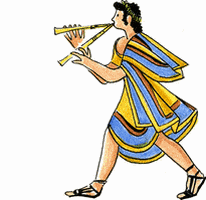
|
ETRUSCAN COINAGE
Etruscan coinage is certainly not the easiest subject to deal with, and the collector who wishes to get involved in it will find it an original field, but one where he may feel a little lonely.
First of all, it should be noted that the Etruscans, just as the Phoenicians, did not receive the invention of metal coins with the same enthusiasm as the Greeks. Another common point with Phoenicia, is that coins produced in Etruria remained issued on the initiative of each of the cities, which were quite independent.
When metal coins first appeared in the first cities, Etruria was no longer at the height of its power and experienced its first defeats against the Romans.
Indeed, the Etruscans seem to have been inspired to adopt coinage by the gold and silver coins minted in Magna Graecia (south of Italy and Sicily), and in particular in the colony of Cumae which is located close to the Etruscan southern border.
They were also inspired by the currency system based on the “heavy bronze” (Aes Grave), which spread in the Roman Republic at the beginning of the 3rd century B.C. (the Roman republic began in 509 B.C., with the fall of the last king, Tarquinius Superbus - an Etruscan – deposed by the patrician aristocracy).
Silver coinage and Greek influence
The first silver coins seem to have appeared in Vulci and Populonia, in the 5th century B.C., with issues of tridrachms, didrachms, staters and drachms. Those currencies (475-470 B.C.) adopted the Chalcidian standard used in Cumae and in Sicilian cities with which the Etruscans traded, cities like Himera or Messine (Zancle). Their style remained overall Greek. They often depict fabled creatures from which the Etruscans expected protection. At the end of IVth century B.C., the coins from Populonia were marked with their value on the coin, following the example of coins from Magna Graecia (Sicily especially). The coins marked “5” are equivalent to 5 units of a 2,25 gram silver weight, their value being the same than that of a bronze Aes. They were followed by others having a value of 20,10 or 5, based on a silver unit of 1,13 grams only (half the previous standard, as though silver had doubled in value). Attic and Corinthian standards (a Corinthian stater = 2 Attic drachms) were also used, as well as gold coins.
Bronze coinage and Roman influence
As far as bronze coins are concerned, they apparently derived direct from the bronze ingots used as currency in middle Italy in the 5th century B.C.
About 280 B.C., the Romans used for their bronze coinage (Aes grave) the standard libra of 325 gram, divided into 12 ouncia of 27 grams, or 288 scripula of 1,13 gram.
The Etruscan bronze coins, which were cast in the beginning, seem to follow the Roman standards, even in their devaluations (this may explain the doubling in value of the silver coins). About 214, the coins were minted. Those from Populonia and Vetulonia comply exactly with the Roman standard. The attribution of the coins that were found, to the various cities of origin (Populonia, Volterra, Vulci) as well as their dating, was difficult and discussed at length. A tricky subject for the collector!
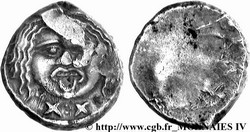
Populonia, ca. 211 B.C. Didrachm ? or 20 Assi, Etruscan (euboïco-attic) standard, silver, diameter 20mm. |
POPULONIA
Populonia was located on the Tyrrhenian coast, close to today’s Piombino. The city is quoted by Virgil (Aeneid, 10,172) and by Livy (28, 45,15). Italo Vecchi, in the Swiss Numismatics Review, recently built up a corpus of this coinage (The Coinage of the Rasna. A Study in Etruscan Numismatics, SNR, 67,69,71 and 72,1988-1992). This coin is from the period of the Second Punic War (221-202 B.C.). 20 Assi correspond to 2 Roman denarii. The denarius weighs 4 scripula or 4,50 gram. Our coin should have a theoretical weight of 9,00 g.
Document CGB, www.cgb.fr |
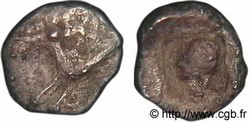
Populonia, ca. 500 B.C., Litra with the Hippalektryon, Euboico-chalcidian standard, silver, diameter 10mm.
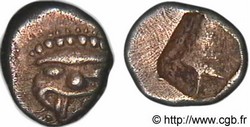
Populonia, ca. 500 B.C., Hemilitron with Gorgona’s head, Euboico-chalcidian standard, silver, diameter 7mm. |
POPULONIA
Populonia was located on the Tyrrhenian coast, close to today’s Piombino. The city is quoted by Virgil (Aeneid, 10,172) and by Livy (28, 45,15). Mrs. M. Cristrofani Martelli, who studied the treasure of Volterra, allots the archaïc currencies with the Hippalektryon to the Populonia workshop rather than that of Volterra. These coin, with a weight of ca. 1,00 g, are often found in the coastal area located in France between the “Etang de Berre” and the sea, and demonstrates the trading relations which existed already at the end of the VIth century and the beginning of Vth century B.C. between the Etruscans and Phoceans of Marseilles. More recently, Italo Vecchi, in the Swiss Numismatics Review, built up a corpus of this coinage, (The Coinage of the Rasna. A Study in Etruscan Numismatics, SNR, 67,69,71 and 72,1988-1992).
Document CGB, www.cgb.fr |

Vulci, ca. 300-217 B.C., 10 scruples
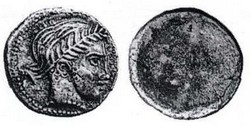
Populonia, ca. 300-217 B.C., 5 asses |
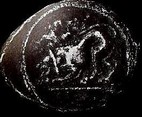
Vulci
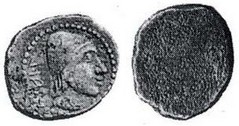
Vetulonia, nomos, ca. 215 B.C.
Documents Mysteriousetruscan,
http://www.mysteriousetruscans.com |
|



















